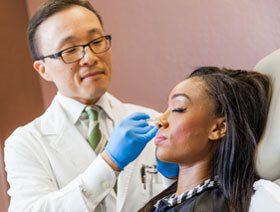Skin Cancer Overview
Skin cancer basically is the most common type of cancer of the human body. All skin cancers combined far outnumber all the internal cancers within the human body. Typically, there are about three and a half million cases of skin cancer in the United States every year.There are three major types of skin cancer, basal cell carcinoma which is the most common type of skin cancer. There are approximately 2.7 to 2.8 million cases annually, making it the most common cancer of the entire human body. The second most common skin cancer is squamous cell carcinoma, typically about 700,000 to 750,000 cases a year in the United States.
Melanoma is the third most common skin cancer but is the cancer that gets the most press, if you will, because even though melanoma makes up only 2% of all skin cancers it accounts for the vast majority of skin cancer deaths.
As a new patient, first and foremost you have to understand that we will make sure that we take care of your concerns. We will take care of your concerns, and we will do it in a compassionate manner. We all have listening ears, and from the top level of the providers down to the support staff we want to make sure that we make your experience as comfortable and as enjoyable as possible. No one has fun going to a doctor’s office, but if you’re going to a medical office you want to make sure that you’re taken care of in a professional fashion and a compassionate fashion, and we’ll make sure we do that.
In addition, we want to make sure that you leave understanding that we will address all your concerns. In addition to that, we will offer whatever treatment is best for you. We have the luxury of having every treatment available to us. So whatever we select within the armamentarium we will pick the best treatment for you that, once again, fits your concerns, your lifestyle, and your disease state.
Skin cancer is the most common form of cancer found in the United States. In addition to having 3.5 million cases per year in the country, Arizona ranks exceedingly high as second in the world for the number of skin cancer incidents, only behind Australia. Because Arizona is such a dangerous environment for skin, it is essential for you to take care of your skin.
Skin cancer includes a wide range of cancers that begin to form abnormal skin cells caused by uncontrolled growths. It is important to check for any signs of skin cancer or unfamiliar moles that begin to develop overtime. Taking preventative measures such as applying sunscreen and reducing the amount of sun exposure are only the first steps to remain cancer-free. We recommend visiting us one to two times a year for full skin exams to ensure your skin stays healthy.
The three main types of skin cancer include Basal Cell Carcinoma, Squamous Cell Carcinoma, and Malignant Melanoma. It’s important to find out which type of skin cancer you have to understand your skin cancer treatment options.
Basal Cell Carcinoma
Basal cell carcinoma (BCC) is the most common type of cancer found in the human body. It begins as a locally destructive tumor that arises in the body’s basal skin cells. The formation of BCCs are typically caused by cumulative intense sun exposure. These BCCs form in the deepest layer of the skin as uncontrollable growths that can progress and basically damage blood vessels, muscle tissue, and other nerve endings. With early detection and the proper treatment, BCC can be eliminated. Removing the original tumor site is very important to the body because aggressive basal cell carcinoma has the ability to spread to other areas of the skin and can be locally destructive and disfiguring. BCCs often look like open sores, red patches, pimple-like growths, shiny bumps or scars.After you are diagnosed with BCC, there are a number of surgical and nonsurgical options to help treat this form of skin cancer. Depending on the size, location, and characteristics of the tumor, as well as the overall health needs of the patient, we provide the ideal treatment to assess the problem properly. While basal cell carcinoma is a serious issue which can lead to permanent disfigurement, it rarely spreads to other areas in the body. Early diagnosis is necessary to prevent further complications.
Squamous Cell Carcinoma
Squamous cell carcinoma (SCC)is the second most common type of skin cancer. It is a type of carcinoma cancer that may occur in many different organs, including the skin, lips, mouth, esophagus, urinary bladder, prostate, lungs, vagina and cervix. SCCs may appear as a red crusted or scaly patch on the skin, a non-healing ulcer, or a firm red nodule on areas that are most exposed to the sun such as the ears, nose, head, neck, torso and arms.With early detection and proper treatment, SCC can be removed and easily treatable. Understanding the signs and recognizing SCCs early increases the cure rate and minimizes your odds of further extensive treatments. If left untreated, aggressive squamous cell carcinomas (especially of the ears and lips) have a greater risk for spreading to the lymph nodes and other internal organs.
Malignant Melanoma
Malignant melanoma is a type of cancer that begins in the skin. It is treatable and possible to remove when detected early, but can be fatal to your health if allowed to progress and spread. Melanoma is a cancer of the pigment producing cells in the skin, known as melanocytes. Normal melanocytes reside in the outer layer of the skin and produce the brown pigment melanin, which is responsible for the color of our skin. Melanoma occurs when melanocytes become cancerous, grow and invade other tissues.We are not certain how all cases of melanoma develop; however it is clear that if you endure excessive sun exposure, especially severe blistering sunburns during childhood or persistent indoor tanning, you may be increasing your risk of developing melanoma. Although moles and brown spots on the skin are usually harmless, anyone who has more than 100 moles is also at a greater risk for melanoma. The first signs can appear in one or more atypical moles, which is why it’s so important to get to know your skin very well and to recognize any changes in the moles on your body.
If you have seen any signs of skin cancer, make an appointment for a skin cancer screening right away. Depending on the type of skin cancer, the severity, and your needs and budget, we will work with you to find the best skin cancer treatment for you. Read more about our skin cancer treatments and schedule an appointment to come see us!
Actinic Keratosis
Actinic keratosis, also known as A.K.S., are precancerous conditions of the skin. When I say precancer that is really meaning basal cell and squamous cell carcinoma. These tend to develop in fair skinned individuals and more commonly on sun exposed areas.
The signs of actinic keratosis is a rough adherent scale. What most patients are going to describe them as is basically a scab that just does not want to fall off, and sometimes if they scratch it hard enough it can bleed. Approximately 10 to 30% of these can go on to develop into non-melanoma skin cancer.
Prevention of actinic keratosis is best achieved through sun protective measures. First is sunscreen. Now the important thing to know about sunscreen, that a lot of people do not know, is that S.P.F. tells you only how much U.V.B. rays it protects you from. Now that doesn’t tell you about how much U.V.A. it protects you from and U.V.A is equally causative of these. So it’s very important that when you are buying sunscreen, that it should have an S.P.F. of 30 or better, but also on the label it should say broad spectrum protection.
The other thing that works really well, they have new U.P.F. shirts which are long sleeve or short sleeve shirts and you put that on and that will alleviate the necessity to put sunscreen all over your upper body. I also recommend wide brim hats because skin cancers and precancers are very common on the ears.
Actinic Keratosis is a dry, scaly, rough bump that is typically anything from skin-colored to reddish-brown. Actinic keratosis can also be referred to as “solar keratoses” or “sun spots.” Fair-skinned people are more susceptible, and actinic keratosis tends to appear on skin that receives the most sun such as the forehead, ears, neck, arms, hands, lower lip, a bald scalp and lower legs. No matter where actinic keratosis develops, it is considered the earliest stage in the development of skin cancer. Actinic keratoses may be removed by liquid nitrogen—a simple, quick and rather painless treatment in which the area is frozen off—but if you have many actinic keratoses, additional treatment options may include photodynamic laser therapy, chemical peels, or prescription creams.Keeping your skin well moisturized is a great way to maintain healthy skin and help avoid the risk of developing actinic keratosis. If your skin begins to itch, develop red bumps, or appears to have a sand-paper like texture for a long period of time, contact us for a professional diagnosis.
Dysplastic Nevus
Skin Cancer Treatments
If you see any signs of skin cancer, make an appointment for a skin cancer screening immediately. We will perform a full skin cancer screening and if anything is found, we will work with you to find the best skin cancer treatment for you. We have a wide range of treatments from Mohs Therapy, Brachytherapy, and many other additional skin cancer treatments. Depending on the type of skin cancer found, the severity, as well as your needs and budget, we will work with you to find the best treatment for you.


